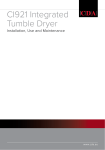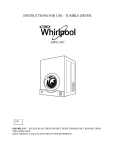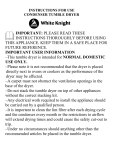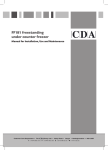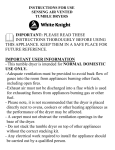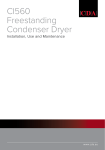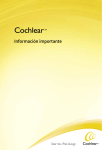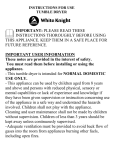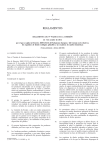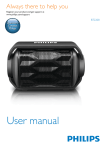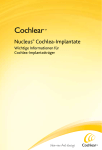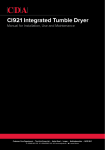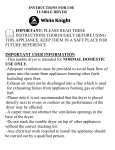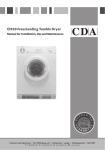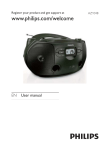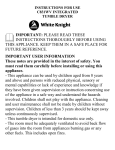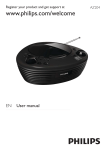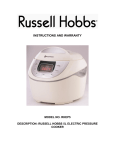Download CDA CI522
Transcript
CI522 Freestanding Tumble Dryer Installation, Use and Maintenance Customer Care Department • The Group Ltd. • Harby Road • Langar • Nottinghamshire • NG13 9HY T : 01949 862 012 F : 01949 862 003 E : [email protected] W : www.cda.eu www.cda.eu User Information The room must be adequately ventilated to avoid the backflow of gases into the room from appliances burning gas or any other fuels. This includes open fires. It is important to clean the lint filter after each drying cycle. Items that have been soiled with substances such as cooking oil, acetone, alcohol, petrol, kerosene, spot removers, turpentine, waxes and wax removers should be washed in hot water with an extra amount of detergent before being dried in the tumble dryer. Fabric softeners, or similar products, should be used as specified by the fabric softener instructions. Remove all objects from pockets such as lighters and matches. We recommend that the appliance is switched off each time after use. It should be disconnected from the electricity supply if it is to be unattended for long periods, ( i.e. weekends or holiday etc). This machine is unsuitable for use with an external time clock. Do not •Overload the dryer. •Dry articles singly as they tend to roll up and so increase drying time. 2 •Dry anything other than the recommended articles in the tumble dryer. These can cause fires. •Place articles which have been in contact with dry cleaning fluid, petrol, cooking oil, fat, hair lacquer or other flammable substances in the tumble dryer. •Attempt to dry dripping wet articles. •Dry unwashed items in the tumble dryer. •Dry wool or wool mixture articles unless the article is labelled as suitable. This should avoid shrinkage. •Dry items such as foam rubber (latex foam), shower caps, waterproof textiles, rubber backed articles and clothes or pillows fitted with foam rubber pads. •Discharge exhaust air into a flue which is used for exhausting fumes from appliances burning gas or other fuels. •Allow the vent hose (where applicable) or filter to become blocked. •Allow lint to accumulate around the tumble dryer. •Use a two-way or multi-way adapter, or extension lead. The dryer must be connected to its own individual 13A socket. •Use the tumble dryer if you suspect that it is damaged in any way. Never switch the dryer off and leave a hot load in the drum – risk of fire. WARNING: Never stop a tumble dryer before the end of a drying cycle unless all items are quickly removed and spread out so the heat is dissipated. 3 This label positioned on the rear of your dryer, indicates the surface is hot when in operation – CAUTION avoid touching. HOT SURFACE Important This appliance must only be used for the purpose for which it is intended, i.e. domestic use. Any other use could be dangerous and may lead to premature failure of the appliance. The CDA Group Ltd cannot be held responsible for injuries or losses caused by incorrect use or installation of this product. Please note that CDA reserve the right to invalidate the guarantee supplied with this product following incorrect installation or misuse of the appliance. This appliance can be used by children aged from 8 years and above and persons with reduced physical, sensory or mental capabilities or lack of experience and knowledge if they have been given supervision or instruction concerning use of the appliance in a safe way and understand the hazards involved. Children shall not play with the appliance. Cleaning and user maintenance shall not be made by children without supervision. Under no circumstances should any external covers be removed for servicing or maintenance except by suitably qualified personnel. 4 Appliance information: Please enter the details on the appliance rating plate below for reference, to assist CDA Customer Care in the event of a fault with your appliance and to register your appliance for guarantee purposes. Appliance Model Serial Number CE Declarations of Conformity: This appliance has been designed, constructed and marketed in compliance with safety requirements of EEC Directives 2006/95/EEC & 2014/35/EU (Low voltage) and requirements of EMC Directives 2004/108/EEC & 2014/30/EU. This product is manufactured to comply with the radio interference requirements of the Council directive 82/336/EEC. IMPORTANT INFORMATION FOR CORRECT DISPOSAL OF THE PRODUCT IN ACCORDANCE WITH EC DIRECTIVE 2012/19/EU. At the end of its working life, the product must not be disposed of as urban waste. It must be taken to a special local authority differentiated waste collection centre or to a dealer providing this service. Disposing of a household appliance separately avoids possible negative consequences for the environment and health deriving from inappropriate disposal and enables the constituent materials to be recovered to obtain significant savings in energy and resources. As a reminder of the need to dispose of household appliances separately, the product is marked with a crossed-out wheeled dustbin. 5 Use and Controls B C A fig. 1 A. The timer - turn the timer knob anticlockwise until the required programme time around the timer knob is selected. B. Heat setting - select gentle or intensive heat recommended on the control panel. as C. Start - press the start button after selecting the required drying time. •Sort out the clothes into groups of similar fabrics and colours. Check the care label inside the garment. We suggest that fabric conditioner be used to reduce static electricity. Delicate articles e.g. tights should be placed inside a pillowcase. It is better to dry small and large articles together. • Open the door. • Load clothes loosely into the drum. • Load sheets first starting with one corner. • Close the door. • Dry your hands. • Check the timer is in the “0” position. • Switch on the machine. 6 •Select correct heat position. •Set the timer to the correct position (See programme around the timer on fascia panel). •For energy labelling purposes (EN61121:2005) for a cotton dry load, use the maximum load weight for cotton and set the timer to the recommended drying time for cotton dry as specified on the control panel. •The standard cotton programme used at full and partial load is the standard drying programme to which the information in the label and the fiche relate. This programme is suitable for drying normal wet cotton laundry. It is the most efficient programme in terms of energy consumption for cotton. •Your appliance is a reversing, small door opening, dryer. A full load will typically take 130 minutes and will use approximately 4.48kWh of electricity. A half load will typically take 75 minutes and will use approximately 2.32kWh of electricity. • Press the start button. •The drum will now begin to rotate and will stop automatically when the timer reaches the “0” position. • Once the clothes are removed, clean the filter. • Switch off the electricity supply. Should the clothes become dry before the cycle has finished the thermostat will automatically switch off the heater to prevent over drying and save energy although the drum will still rotate. When drying large items, such as sheets, we suggest you stop the dryer periodically to redistribute the load. 7 To stop the machine in the middle of a programme, open the door: The drum will stop rotating automatically and reset when you close the door. To lengthen or shorten the programme, turn the timer knob. The final part of the drying cycle occurs without heat (cool down cycle) to ensure that the items will not be damaged. Care labels you may find on your fabrics ‘Suitable for tumble drying’ ‘Do not tumble dry’ ‘Dry flat’ Sticker The sticker below, found on your tumble dryer, is a polite reminder for the user to read the instruction manual. 8 Care and Maintenance Cleaning The Filter The filter is found by opening the door (fig. 2) and must always be in position when drying items in the appliance. To allow the dryer to operate efficiently the filter should be cleaned after each drying cycle. fig. 2 Do not be alarmed by the amount of lint deposited on the mesh. It is not due to excessive wear caused by the dryer but more an indication of its efficient operation. All fabric loses lint when drying but it goes unnoticed into the air. In a tumble dryer it simply collects in the filter. After removing the dried clothes, clean the filter as follows: • Pull the filter upwards. • Remove any threads or lint by hand or with a soft brush. • Slide the filter back. • Wash the filter occasionally in detergent solution and remove small particles with a soft brush. 9 Troubleshooting If the clothes are not dry after normal drying time: - Check that the filter is clean. - Check that you used the correct heat setting. - Check that the vent hose is not blocked (sometimes a strong wind may cause a back pressure). - Check that you have not set the timer within a cool down period. If your appliance does not work, check the following points before contacting CDA Customer Care • Check that there is power to the appliance. •Check that the machine is switched on and the door is properly closed. •This appliance has a resettable cut-out. Check this has not been activated. Press the red button on the right hand side at the back of your dryer. If the cut-out has been activated a “click” will be heard. This cut-out only operates if the airflow is severely restricted so make sure the filter is clean and that all other restrictions are removed before restarting. • Check the fuse in the moulded plug. 10 Installation Do not block the vent at the front or base of the dryer as this will impair the functioning of the appliance and could cause it to overheat. This appliance must not be installed behind a lockable door, a sliding door or a door with hinges on the opposite side to that of the tumble dryer. fig. 3 Tumble Dryer Venting Your tumble dryer will release warm, damp air in one of three ways. 1) Extendable rear venting - a long flexible vent hose is built into the dryer and can be extended from the large opening at the rear of the machine. 2) Fixed rear venting - venting is through the large opening at the bottom of the rear panel. A separate extendable vent hose can be attached if desired. 3) Front venting - this is a special type of dryer which vents through a grille on the plinth. The opening on the rear panel is blanked off during manufacturing. Rear vented dryers can be used without a vent hose but not in a confined space. Rear vented machines must have a vent hose if they are installed under a work surface. To minimise condensation it is preferable to vent to outside. This may be through an open door 11 or window. The best solution is to connect the vent hose to a permanent connection through a wall or a single glazed window. This is particularly recommended for small, cool rooms. Front venting machines must be converted to extendible rear venting before a permanent connection can be made to the outside. When using a vent hose, remember the following points: •The vent hose must be at least 10cm (4”) in diameter. •No more than three right-angled bends should be allowed when positioning the vent hose. •Do not distort or constrict the vent hose as this will reduce the airflow. •The vent hose must not be shared with other appliances, for example, a cooker hood outlet. 12 Reversing the Door The door on the dryer can be positioned either with the left or right hand hinging, as shown in figure fig.4. Please note: power tools must not be used when reversing the door. fig. 4 13 Electrical Information Warning! This appliance must be earthed. Green and yellow to Earth A 13 Amp Brown to Live B 13 Amp fuse Cord clamp Blue to Neutral The mains lead of this appliance has been fitted with a BS 1363A 13 amp fused plug. To change a fuse in this type of plug, follow the steps below: 1.Remove the fuse cover and fuse. 2.Fit a replacement 13A fuse, ASTA approved to BS 1362 type, into the fuse cover. 3.Replace fuse cover. Important: Do not use the appliance without the fuse cover in position. How to connect an alternative plug If the fitted plug is not suitable for your socket outlet, then it should be cut off and disposed of safely to prevent the risk of electric shock. A suitable alternative plug of at least 13Amp rating to BS 1363 should be used. 14 As the colours of the wires in the mains lead of this appliance may not correspond with the coloured markings identifying the terminals in your plug, proceed as follows:• The wire which is coloured GREEN and YELLOW must be connected to the terminal which is marked with letter (E) or by the Earth symbol or coloured GREEN and YELLOW. • The wire which is coloured BLUE must be connected to the terminal which is marked with the letter (N) or coloured BLACK. • The wire which is coloured BROWN must be connected to the terminal which is marked with the letter (L) or coloured RED. If in doubt regarding the electrical connection of this appliance, consult a qualified electrician. Do not shorten the supply cable, the appliance may require removing for servicing. N.B. Ensure that the plug socket is situated in an easily accessible place. If the power supply cord is damaged, it must replaced by a CDA authorised agent. 15 Technical Information: Overall dimensions : 85cm x 59.5cm x 58cm (height x width x depth) Maximum dry weight: Cotton or linen 7.0kg. Maximum dry weight: Synthetics 7.0kg. Fuse rating: 13A For electrical ratings see plate on rear of machine. Room temperature range 5˚C to 30˚C. (Drying performance decreases as room temperature falls). Your washing machine should have a spin speed of not less than 1000rpm for maximum efficiency. 16 NOTES: 17 NOTES: 18 Suppliers name or trade mark Model identifier Rated capacity at full load Appliance type Energy efficiency class Energy consumption of the appliance CDA CI522 7kg Air Vented C 519kWh The figures above are based on 160 drying cycles of the standard cotton programme at full and partial load and the consumption of the low-power modes. Actual energy consumption per cycle will depend on how the appliance is used. Automatic/non-automatic EU Ecolabel Edry Non-automatic N/A 4.48kWh Edry½ 2.32kWh Egdry N/A Egdry½ N/A Egdry,a N/A Egdry½,a N/A Off mode power (Po) 0W Left on mode power (P l) 0W Duration of left-on mode N/A The standard cotton programme used at full and partial load is the standard drying programme to which the information in the label and the fiche relates. This programme is suitable for drying normal wet cotton laundry. It is the most efficient programme in terms of energy consumption for cotton. 99mins Tt Tdry 130mins Tdry½ 75mins Condensing efficiency class Ct N/A N/A Cdry N/A Cdry½ Sound power level Built in/not built in N/A 62dBA Not built in E & O E. All instructions, dimensions and illustrations are provided for guidance only. CDA reserve the right to change specifications without prior notice. 19 4213 194 16431 Please contact our Customer Care Department for Service on the details below Customer Care Department The Group Ltd. • Harby Road • Langar • Nottinghamshire • NG13 9HY T : 01949 862 012 F : 01949 862 003 E : [email protected] Customer Care Department • The Group Ltd. • Harby Road • Langar • Nottinghamshire • NG13 9HY T : 01949 862 012 F : 01949 862 003 E : [email protected] W : www.cda.eu Copyright © CDA 2015 www.cda.eu





















